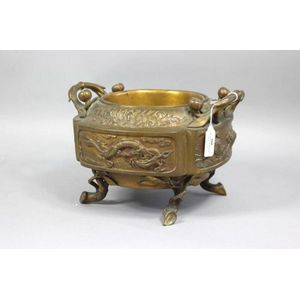Chinese Qing Dynasty Bronze Dragon Censer
You must be a subscriber, and be logged in to view price and dealer details.
Subscribe Now to view actual auction price for this item
When you subscribe, you have the option of setting the currency in which to display prices to $Au, $US, $NZ or Stg.
- Chinese Ding Porcelain - Ding ware is a type of Chinese porcelain that was produced in the northern city of Ding in the Hebei province during the Song Dynasty (960-1279). It is considered to be one of the "Five Great Kilns" of Chinese ceramics, along with Jian, Jun, Guan, and Ru wares.
Ding ware is known for its fine white porcelain body, which was made from kaolin clay, and its elegant shapes and designs. The glaze on Ding ware is usually transparent and has a bluish-white or grayish-white color. It was often decorated with underglaze blue or iron-brown designs.
Ding ware was highly prized during the Song Dynasty, and it was exported throughout Asia and as far as the Middle East and the Mediterranean. It was also an inspiration for other porcelain-making centers in China and Japan. The production of Ding ware declined after the Song Dynasty, and it is now considered to be a rare and valuable collectible. - Ming Dynasty - The Ming Dynasty was a ruling dynasty of China from 1368 to 1644. It succeeded the Yuan Dynasty and preceded the Qing Dynasty. The Ming Dynasty was established by Zhu Yuanzhang, a former Buddhist monk who became a rebel leader and eventually overthrew the Mongol Yuan Dynasty. During the Ming Dynasty, China experienced a period of relative stability and prosperity. The government was centralized and bureaucratic, with the emperor at the top of the hierarchy. The Ming Dynasty is known for its cultural achievements, including the development of porcelain, the invention of movable type printing, and the construction of the Great Wall of China.
- Bronze - An alloy of copper and tin, traditionally in the proportions of about 9 parts of copper to 1 part of tin.
The discovery of bronze in Western Asia in the 4th century enabled people to create metal objects which were superior to those previoulsy possible because of its strength and hardness, and it has been used throughout the world for weapons, coins, tools, statuary and other decorative items.
It is very fluid in a molten state, and its hardness, strength when set, and non-corrosive properties makes it most suitable for casting sculpture. - Qing Dynasty - The Qing Dynasty was the last imperial dynasty of China, ruling from 1644 to 1912. It was established by the Manchu people, who originated from the northeastern region of China. The Qing Dynasty was preceded by the Ming Dynasty and followed by the Republic of China.
This item has been included into following indexes:
Visually similar items

A Chinese porcelain white glazed censer, squat circular shape, raised on three lion mask feet, decorate with foo dogs and pups in high relief to the side. Impressed Daoguang seal mark under the base. Height 19 cm

Antique Chinese gilt bronze twin handled censer, handles in the form of fruiting vines, standing on branch form feet, six reign character mark to base, approx 18.5 cm high, 28.5 cm wide

A Victorian sterling silver three piece silver tea service, maker's mark Samuel Hayne & Dudley Carter / London, circa 1848-1849, comprising a teapot, a sugar vessel and a creamer, each with a lobed body, 1442grs. Total weight, the teapot 19 cm high

A George III silver cream jug, the swollen ovoid body with foliate and scroll engraved and embossed decoration, vacant cartouche to the front, shaped rim, double scroll handle, raised on three pad feet. Probably London 1775, marks partially worn.
